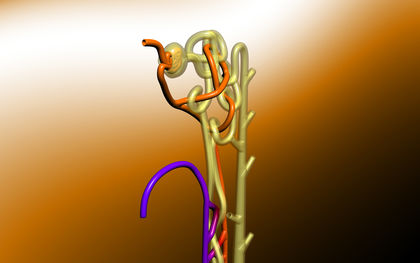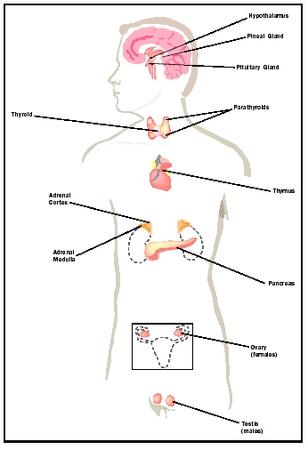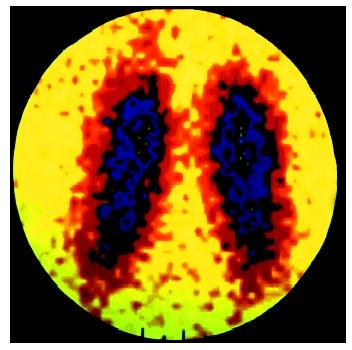Endocrine System

The endocrine system is the interacting group of glands that secrete hormones , helping to control cells and organs throughout the body. How do cells and organs at different locations in the body communicate with each

There are similarities and differences between how the human nervous system and endocrine system communicate with and control other organs. For example, the nervous system relies on electrical impulses and chemical neurotransmitters . Most endocrine organs do not transmit electrical information but instead secrete hormones (from the Greek, meaning "to arouse or excite"), which are molecules that act as chemical messengers. Hormones are released into the bloodstream whereby they travel to organs they affect, known as target organs.
Endocrine organs are located throughout the body, and they have diverse functions controlling events such as cell metabolism , blood sugar concentration, digestion, the menstrual cycle in females, and the production of male and female gametes . Primary endocrine organs include the hypothalamus, pituitary gland, pineal gland, thyroid and parathyroid glands, thymus, adrenal glands, pancreas, and male and female gonads, the testes and ovaries respectively. Other tissues serve endocrine functions through the hormones they produce. For example, the kidneys produce erythropoietin that stimulates formation of red blood cells, and the skin produces vitamin D, a steroid derivative required for calcium absorption by the small intestine.
Hormones
Hormones are "signaling" molecules because they influence the activity of other cells that may be far from where the hormone was produced. For a hormone to affect a target cell, it must attach to a receptor protein on the target cell membrane or inside the cell. Hormone binding to a receptor triggers an intricate set of biochemical interactions that can affect the target cell in myriad ways. For example, hormones can influence cell metabolism, cell division, electrical activity, ribonucleic acid (RNA) and protein synthesis, or cell secretion .
There are several different types of hormones that vary in their chemical organization and functions. The majority of hormones are peptides. These consist of short sequences of amino acids ; examples include insulin and growth hormone. The class of hormones called steroids are synthesized from cholesterol—examples include male sex steroids such as testosterone and female sex steroids such as estrogen and progesterone.
Hormone production by an endocrine organ is regulated by complex interactions, called feedback loops, between the endocrine organ and its target organs. Feedback loops are two-way modes of communication in which a target organ also releases molecules that regulate the endocrine organ. Feedback loops are designed to maintain hormone concentration within a normal range. Endocrine disorders in which hormone concentration becomes abnormal can be difficult to diagnose and treat because of the complexity of feedback loops. One simple way to classify endocrine disorders is based on whether a condition is due to excess production (hypersecretion) or underproduction (hyposecretion) of hormone.
The Major Endocrine Glands
Located at the base of the brain, the pituitary gland produces many hormones that regulate other organs. Because of this, the pituitary is often referred to as the "master" endocrine gland, although the term "central" endocrine gland is more correct because hormone release by the pituitary is primarily regulated by a brain structure called the hypothalamus, which acts to connect the nervous system to the endocrine system. The hypothalamus produces hormones that stimulate or inhibit the release of pituitary hormones. The hypothalamus also produces antidiuretic hormone, which regulates water balance in the body by inhibiting urine formation by the

Hormones released by the pituitary include growth hormone, which increases during childhood and stimulates the growth of muscle, bone, and other tissues. Sporadic bursts in growth hormone release often result in rapid growth "spurts" associated with adolescence. Hyposecretion of growth hormone can result in dwarfism, whereas hypersecretion of growth hormone can cause gigantism and other disorders. The pituitary also produces follicle-stimulating hormone and luteinizing hormone, which stimulate gamete production and sex steroid production in male and female reproductive organs, and prolactin, which stimulates milk formation in the mammary glands.
Located adjacent to the larynx , the thyroid gland primarily produces thyroxine and triiodothyronine, collectively referred to as thyroid hormone. Thyroid hormone stimulates growth of muscles and bones, carbohydrate metabolism, and basal metabolic rate. Its production requires iodine; the lack of dietary iodine causes goiter, a thyroid gland that is overly enlarged in an effort to compensate for the thyroid hormone deficiency.
Effects of thyroid disorders in children and adults can differ widely. For example, hyposecretion of thyroid hormone in infants causes congenital hypothyroidism, a disease characterized by mental retardation and poor body growth; hyposecretion in adults produces myxedema, with symptoms such as lethargy , weight gain, and dry skin. Conversely, hypersecretion of thyroid hormone in adults causes Graves' disease, a condition characterized by weight loss, nervousness, and dramatic increases in body metabolism. The thyroid also produces calcitonin, a hormone that regulates blood calcium concentration.
The adrenal glands are small organs on the apex of each kidney. The outer layers of cells in the adrenal gland, called the adrenal cortex, produce several hormones that affect reproductive development; mineral balance; fat, protein, and carbohydrate balance; and adaptation to stress. The inner part, called the adrenal medulla, secretes epinephrine and norepinephrine, which activate the sympathetic nervous system and stimulate the "fight-or-flight" response that helps the body cope with stressful situations, such as fear.
The pancreas produces insulin and glucagon, which function in opposing fashion to regulate blood sugar (glucose) concentration. When blood glucose level rises—for example, after eating a sugar-rich meal—insulin lowers it by stimulating glucose storage in liver and muscle cells as long chains of glucose called glycogen . Conversely, between meals, blood glucose level decreases. In response, the pancreas releases glucagon, which stimulates glycogen breakdown and subsequent release of glucose into the bloodstream. One of the most well characterized endocrine disorders is diabetes mellitus, resulting from hyposecretion of insulin or, more commonly, target cell insensitivity to it.
Endocrine functions of the gonads are addressed in articles on the male and female reproductive systems. The sex hormone testosterone regulates sperm production in males. Estrogen and progesterone influence egg maturation and release (ovulation) and control the uterine (menstrual) cycle in females.
Although the many hormones produced by human endocrine organs have a wide variety of actions, the common purpose of all hormones is to facilitate organ-to-organ communication necessary for body physiology.
SEE ALSO Adrenal Gland ; Anabolic Steroids ; Blood Sugar Regulation ; Female Reproductive System ; Growth ; Homeostasis ; Hormones ; Hypothalamus ; Nervous Systems ; Pancreas ; Pituitary Gland ; Stress Response ; Thyroid Gland
Michael A. Palladino
Bibliography
Hadley, Mac E. Endocrinology, 5th ed. Upper Saddle River, NJ: Prentice Hall, 2000.
Marieb, Elaine Nicpon. Human Anatomy and Physiology, 5th ed. San Francisco: Benjamin Cummings, 2000.
Comment about this article, ask questions, or add new information about this topic: